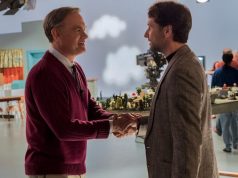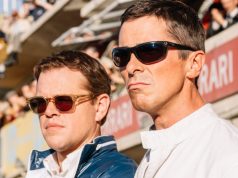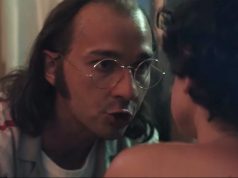As the screenwriter of such loopy, melancholy comedies as “Being John Malkovich” and “Eternal Sunshine of the Spotless Mind,” Charlie Kaufman has been lucky to work with directors like Spike Jonze and Michel Gondry who appreciate — and can translate to the big screen — his singularly bizarre worldview. But he has chosen his sixth screenplay, “Synecdoche, New York,” to direct himself, and as we see him control a project’s vision entirely on his own for the first time, we discover something surprising: He’s even crazier than we thought. Is it possible Jonze and Gondry were actually holding him back?
“Synecdoche, New York” is never explained as a title, apart from being a mispronunciation of Schenectady, N.Y., where much of the story is set. I can tell you that “synecdoche” (sin-ECK-duh-kee) is the name for a figure of speech where something is referred to by one of its parts (calling your car your “wheels,” for example) or vice versa (saying “Use your head!” when you really just mean “Use your brain!”) — but whether that’s relevant, I couldn’t say.
Caden Cotard (Philip Seymour Hoffman) is a theater director in upstate New York with an artist wife, Adele (Catherine Keener), and a precious 4-year-old daughter, Olive (Sadie Goldstein). After Adele takes Olive and moves to Germany, Caden becomes intent on producing a theatrical work that is wholly original and meaningful. “I want to do something important while I’m still here,” he says, echoing the urgent refrain spoken by all artists at one point or another.
His idea is to create a massive, sprawling theater piece in a huge warehouse in New York City, with actors playing him and the people he knows (and, eventually, other actors playing THOSE actors, and so on), all in the interest of conveying the truth and beauty of real life. Theoretically, audiences would meander through the sets he’s constructed, which are scale versions of New York City, and observe the characters in their natural habitats, enacting the dramas and comedies of everyday living.
As usual with Kaufman, the basic story is actually fairly straightforward; it’s the details of the execution that render it whimsical, surreal, and dreamlike. Caden’s box-office manager, a sweet girl named Hazel (Samantha Morton), buys a house that is on fire (“The seller is very motivated”) and that continues to be on fire after she moves in. Characters frequently do not understand each other. (Caden: “I think I have blood in my stool.” Adele: “That stool in your office?”) Young Olive’s diary, left behind when she moved to Germany, has entries in it that she could have only written after the fact, which we hear narrated in Olive’s voice, which now has a German accent. A marriage counselor (Hope Davis) answers questions nanoseconds after you’ve finished asking them, as though she wasn’t listening at all, and has written a book for every possible situation, some of which actually refer to you as you read them.
Weirdness abounds — believe me, what I have mentioned is but a drop in the ocean of the film’s strangeness — but the aspect I find most satisfying is that it passes without comment. Some films have a normal character surrounded by insanity; here, Caden definitely cannot cope with life, but it’s not because weird things are happening. In this universe, life has always been this way. This is just how things are. Caden’s inability to get his bearings and find his happiness is symbolic of what we all go through, regardless of the world we live in, whether it’s the kind of world where people buy burning houses or not.
Kaufman, like Caden, is worried about time, which has little meaning in the film. It’s the first day of autumn in the opening scene; then the radio DJ wishes everyone a happy Halloween, and by the time the scene is over, the morning paper says it’s Nov. 2. Time rushes forward precariously, years at a time, often slipping away from Caden before he realizes it. He has a continuing series of health problems that make him concerned about dying. Life is not a rehearsal, you know — this is it. When we first meet Caden, he is staging a production of “Death of a Salesman.” And who knew about the futility of life and the ever-approaching specter of death better than Willy Loman?
All of this makes it sound like a sad and poignant film, which it ultimately is, all the loony comedy notwithstanding. This will sound strange, but both times I’ve seen the film so far, I’ve come out of it with the sensation I used to have when I was a kid and I would take a nap in the afternoon. I always woke up feeling disoriented and melancholy, mostly because I didn’t like the sensation of having been asleep while the rest of the world was awake. What had happened while I was out? What had I missed? Caden seems to feel like that a lot, unable to get a firm grip on life as it slides past him, and it often gives the film the panicked intensity of a disconcerting dream — not a full-blown nightmare, just a vision that’s slightly “off.” Characters like Claire (Michelle Williams) and Millicent (Dianne Wiest), two of Caden’s actresses, enter and exit his life precipitously. You never know who’s going to be important and who’s going to slip out of the picture without a trace. In that respect, the film feels exactly like real life.
Lots of movies employ a few quirks just so people will call them “quirky.” Kaufman is no quirk hobbyist, however. Quirkiness is so thoroughly entrenched in his writing that one assumes he comes by it naturally, without having to wedge it in. “Quirky,” for Kaufman, would be writing something ordinary and unsurprisingly. “Synecdoche” is uniformly daft, with oddness in every frame, oddness that would take multiple viewings to fully parse and appreciate. Heck, I had to see it twice just to get a handle on which elements are meaningful and which are only there for mirth’s sake. (The pink wooden box labeled “NOSE” that Caden sends to his daughter falls under the latter category, I think.) It’s an utterly brilliant film in that it evokes its intended feelings with apparent effortlessness, not like a staged, contrived snapshot but like a wholly unique piece of art.
A (2 hrs., 4 min.; )





